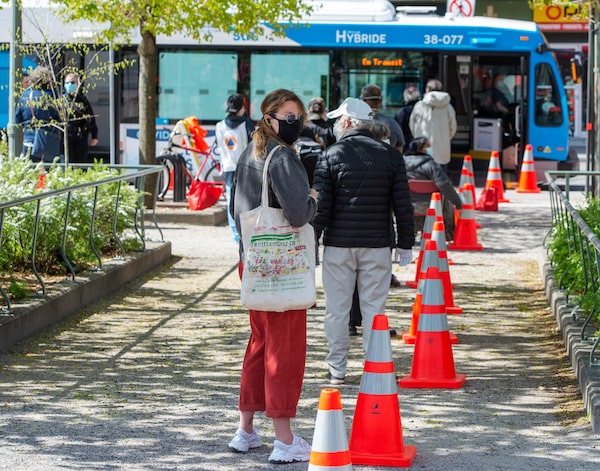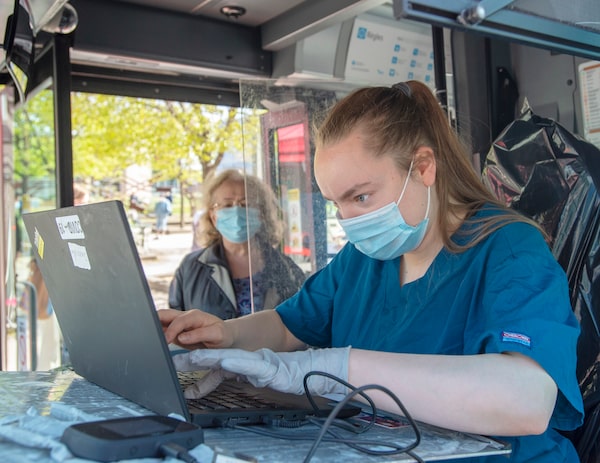
Canada has the capacity to test 60,000 people – mobile testing in Montreal seen here on May 19, 2020 – a day for COVID-19, but has been averaging only about 28,000.Ryan Remiorz/The Canadian Press
The federal government is offering to help provinces with COVID-19 testing and contact tracing as Ontario and Quebec struggle to meet their targets while their economies reopen.
Prime Minister Justin Trudeau on Friday said COVID-19 is still a serious health threat, and testing and tracing the contacts of those who have been infected is crucial to slow its spread. He said Ottawa also plans to help provinces and territories share data they have collected on case numbers.
“In order for people to move around freely and start getting back to normal life, we have to improve our ability to quickly pinpoint the virus and isolate it,“ Mr. Trudeau said.
Health charities call for immediate support from Ottawa amid fears of lasting impacts on research
Liberals, Conservatives, NDP and Greens apply for wage subsidy as donations drop with COVID-19
“The next phase of our collaborative efforts is on testing, contact tracing and data collection. And I’ve told the premiers that the federal government is here to support, facilitate and fund this important work.”
Some 240 employees from Health Canada and the Department of National Defence are already helping Ontario with contact tracing. Ottawa has also funded testing efforts in the province by procuring reagent and other supplies.
Statistics Canada has also offered 1,700 interviewers who can make 20,000 calls a day to help with contact tracing, Mr. Trudeau said. Canada has the capacity to test 60,000 people a day for COVID-19, but has been averaging only about 28,000.
Ontario’s cases have been trending upward, and the province on Friday reported 441 new ones – the highest number since May 8 – even as testing this week reached barely half of the province’s 20,000 test capacity. The Quebec government announced on May 1 that within a week it would double its volume of tests to 14,000 a day – but it has struggled to reach that mark.
Provincial health workers perform coronavirus disease (COVID-19) tests on residents of the remote First Nations community of Gull Bay, Ontario, Canada April 27, 2020. Picture taken April 27, 2020. REUTERS/David JacksonDAVID JACKSON/Reuters
Andrew Morris, medical director of the antimicrobial stewardship program at the Sinai Health System and the University Health Network in Toronto, said Ottawa’s offer to help with contact tracing is complicated by the jurisdictional issue of public health units, but it should have come sooner.
“The bottom line is we need it. And we needed it, like, yesterday,“ he said. “There’s no reason why we couldn’t have had a development over the last two months of software and applications to facilitate having that done so that there would be some way of standardizing it.”
What is the reopening plan in my province? A guide
Coronavirus guide: Updates and essential resources about the COVID-19 pandemic
Ontario Premier Doug Ford said on Friday “all help is appreciated" from the federal government, and he continued to encourage people with COVID-19 symptoms to visit the province’s 144 assessment centres to be tested.
“We’re going to continue focusing on tracing and tracking these cases. But the whole country’s on it right now," he said.
Mr. Ford said he and other premiers have discussed using a phone app in contact tracing, but added that privacy is “very important.” Health Minister Christine Elliott said that with contact tracing, the province believes it has been able to reach 92 per cent of the people it needs to find with 24 hours, but there is “room to do better."
The Premier said Ontario will broaden its testing efforts this weekend to focus on seniors’ homes and asymptomatic and symptomatic health care workers. The province is also looking into potential “hot spots,” primarily in the Greater Toronto Area, and Mr. Ford said he wants truckers, taxi drivers, auto workers and others in the manufacturing sector tested.

Health-care worker Anushka Caroff welcomes people at a mobile COVID-19 testing bus, Tuesday May 19, 2020 in Montreal.Ryan Remiorz/The Canadian Press
Quebec Deputy Premier Geneviève Guilbault told reporters on Friday that the province wouldn’t turn down any offer of help. Quebec National Public Health Director Horacio Arruda said the province has almost reached its testing targets but could benefit from additional resources. “We have to be ready for the summer, we have to be ready for people’s exhaustion, we have to be ready for the next wave."
Officials in Quebec have been in touch with about 500 of the 1,700 Statistics Canada interviewers, Dr. Arruda said.
Quebec has led the way among provinces in phasing out the coronavirus lockdown. For a while, its testing numbers stagnated under 10,000. “I can’t accept that. I am not happy, I’ve told the people concerned,” Quebec Premier François Legault said on May 13.
On Wednesday, the province was able to test 12,654 people. Quebec officials have blamed poor attendance at public testing clinics for the low number. But some have complained of hurdles when they tried to get checked.
Kristy-Lyn Kemp, a licensed practical nurse, looked after COVID-19 patients at Résidence Herron, an elder-care home hit hard by the crisis. Because she was starting a new job at another facility, she tried to get tested in early May, but was turned away because she had no symptoms. She tried again, claiming she had a fever and cough. She tested positive. “I just can’t believe that I had to lie to get tested,” she said on Facebook.
Globe health columnist André Picard examines the complex issues around reopening schools and businesses after the coronavirus lockdown. He says whatever happens as provinces reopen, there's also a second wave of COVID-19 illnesses looming in the fall. André was talking via Instagram Live with The Globe's Madeleine White.
Sign up for the Coronavirus Update newsletter to read the day’s essential coronavirus news, features and explainers written by Globe reporters.
 Laura Stone
Laura Stone Tu Thanh Ha
Tu Thanh Ha